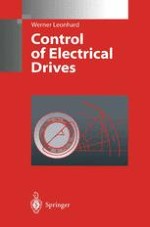1996 | OriginalPaper | Buchkapitel
Some Applications of Controlled Drives
verfasst von : Prof. Dr.-Ing. Dr. h.c. Werner Leonhard
Erschienen in: Control of Electrical Drives
Verlag: Springer Berlin Heidelberg
Enthalten in: Professional Book Archive
Aktivieren Sie unsere intelligente Suche, um passende Fachinhalte oder Patente zu finden.
Wählen Sie Textabschnitte aus um mit Künstlicher Intelligenz passenden Patente zu finden. powered by
Markieren Sie Textabschnitte, um KI-gestützt weitere passende Inhalte zu finden. powered by
The preceding chapters were dealing mainly with the different types of electrical drives and their control; applications were only mentioned as they affected the operation of the machine and the associated equipment. Also, the specifications for a mechanical power supply are normally not met by just one type of electrical drive and the variety of applications can be bewildering. In this chapter the problems of applying controlled electrical drives will be explained in more detail. For this we begin with a 4-quadrant drive, be it DC or AC, the basic structure of which is contained within the dashed lines of Fig. 15.1. The moving masses are at first assumed to be rigidly coupled, represented by a lumped inertia. The inner loop which comprises the power converter and part of the electrical machine assures fast torque control; with an integrating controller it exhibits unity gain and serves for linearisation. Once the torque loop with the equivalent lag T e is closed, there is little difference between a DC and an AC drive. By limiting the torque reference, protection of the power converter and the mechanical load is achieved. Torque control is mandatory on high performance drives, except for the smallest power ratings, because it serves as the controlling input to the mechanical system. Whenever load torque must be counteracted or the speed is to be changed, it is only possible by acting on the torque reference; hence the response of the torque control loop limits the control bandwidth of the complete drive.
